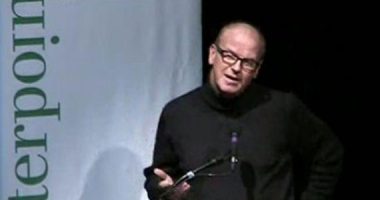A strong idea is one that allows a concentration of questions that substantially affect the evolution of culture. The success of these conferences is based on placing emphasis on the dilemmas posed by five hundred years of textual hegemony and enriching and reopening a debate that has its own genealogy. Dualisms help to simplify the issues to understand them, and polarizations are useful to activate the discussion but, as we all know, the complexity of reality is something that no individual exegete can grasp. So perhaps it is sensible to think that we are inside and outside the Gutenberg parenthesis in a time of transition where the “old world” is not really dead yet and the “new world” is not really born yet. In this impasse, we face a series of processes that directly or indirectly limit the changes in which we are involved and outline a possible post-Gutenberg horizon:
Erosion of the author status
Print culture glorifies the category of the author, but there are lines that challenge this notion by appealing to a full active reader, that modifies, suspends or alters the individual creation of a literary work. If it turns to be true, as Michel Foucault wanted, that the author is a modern invention, there is also a tradition of authors, from Cervantes to Borges, who have helped to erode some of the precepts that underpin the invention: the originality of a piece of work, the taboo against copying, the reliability of sources, the existence of a linear narrative, or internal consistency, etc. The mastery with which Borges manipulates the Western canon, rewrites several timeless stories, imagines the great writers as many (or no one) and undermines erudition by considering it a refined form of cruelty, would be enough to establish that modernity itself implies a permanent suspicion on the powers of a single author, great or omnipotent If we think of art as cinema or theater, the question becomes even more obvious.
“A film is not the creation of an individual but a team of several dozens or even hundreds of people: cinema is by definition a collective art, despite nouvelle vague later tried to impose the idea of politics and authorship to give the work a creative unit that could not technically have” [1]
Dilemmas on intellectual property
Staying or quitting the Gutenberg parenthesis inevitably means going through a serious debate on intellectual property in the age of cognitive capitalism. A debate still riddled with biased arguments, extreme positions and corporate egos. Supporters of traditional copyright, defenders of the interests of a cultural industry that just will not adapt to the impact of new technologies of information are trying to gain time, legislating in fear, ignorance and a peculiar myopia. At the other extreme, the ideologues of a world without copyright [2] are advocating for a utopia that does not answer the crucial questions of a new economy powered by prosumers, contributors and bricoleurs [3]. Maybe reformist positions, such as Lawrence Lessig‘s, are the ones that best interpret the new cultural scene: we need new laws on intellectual property, but it is ethically and intellectually wrong to confuse the remix with theft, to confuse file-sharing with piracy or to criminalize online behavior of younger generations.
Participatory culture
For just over five years 2.0 philosophy has extended to almost all areas of culture, but its mercantilist perversion prevents its implementation from being more rigorous and thorough. The promises of a world of distributed networks where each node can potentially connect with all nodes (as in the blogosphere) is not being met… The most visible criticism considers this “so-called massive participation” as a form of “digital Maoism” or “cyber totalitarinism” [4] and warns us about the differences between participating and interacting or its denounces the centralized nature of major social networks such as Facebook and Twitter [5].
However, it would be wrong not to admit the magnitude of what has been started. When the box opens to participation it becomes more difficult to jusify regressive attitudes. To ensure that participation becomes creative interaction among peers remains a prime target if we really want to create a culture that is more horizontal, open and democratic. “Participation is forever,” warned Hans Ulrich Obrits a few years ago, defining a horizon where the processes of co-creation with users and the intensification of an exchange between professionals and amateurs are among the most controversial and exciting challenges. For this reason, the impasse requires us to identify broken promises, without abandoning in depth tasks. And among them, undoubtedly, is the access to culture in its three forms: access to information, access to production equipment and access to reproduction [6].
Mutation of formats
It may be tempting to say that some formats are decidedly outdated, and new formats have not yet acquired full citizenship. On one side we have the defenders of traditional formats with more or less enthusiasm towards innovations and on the other those willing to support the vertigo of death and the change that somehow continues with the funeral ceremonies that the twentieth century held regarding the novel, theater, film, history and ideologies.
Or, if we put it another way: we witness the survival of “exquisite corpses”, which are still in good health and at the same time, we see a monumental display of invocations towards what is radically new and unique to the first modernity. But are we talking about a late modernity, hypermodernity, the triumph of postmodernism or a chapter of which we do not know the keys to the plot?
The phenomenon of the coexistence of formats that are considered to be obsolete and new genres and formats that are emerging, however, allows us to identify some key processes:
- The crossover effect between the arts and new technologies makes for a general transformation of all genres and formats. There is no genre or format that is not being affected. This does not mean that there are no niches for the survival of minority genres and formats. One can look at what is happening in the audiovisual galaxy, for example.
- The emergence over the past two decades of dynamic (offline) exchanges of knowledge in which the figures of the hacker and geek have a decisive original role, have gradually permeated in the cultural field and have promoted the emergence of new formats ranging from camps (foocamp, barcamp, sex camp, BookCamp, etc.) to the lightning talk, from the design workshops with users to the dilemmas posed by the co-creation of complex projects.
- The dialectic between old and new paradigms in various disciplines and the possibility of ushering a new cultural paradigm that can articulate and structure the innovative tradition of the past three centuries, with the emerging polymorphic innovation of the 21st century.
Expanded education
The classroom, library and museum are traditional areas of learning and knowledge that are undergoing a deep transformation. Maybe the lab, another emblematic space of modernity, is the most resilient to the speed of change, partly because it promotes it, and also because of its specific functions: research, experimentation and innovation. In this sense, cultural labs could be seen as facilitators of new knowledge spaces that are emerging in the 21st century and that, somehow, accelerate the departure from Gutenberg parenthesis. However, one should be cautious with the course and consequences of this process. Placed as we are in the turmoil we do not have enough perspective to understand the nature of transformations in which we operate. The gaps [7] which we face swell creating a critical mass, but no dystopian vision can overshadow the need to continue to deepen into the democratization of culture. In order to think, create and act in this impasse one needs to reconcile a long zoom vision [8] with the inherent difficulties in each context. In order to glimpse the most desirable scenario one should be able to agree on macro views with a myriad of situations where we build every day our future as a species. What kind of humanity we are creating? If culture is moving progressively to a post-Gutenberg era, we should be able to extract relevant lessons from this period, admit its most fruitful memes and be fair to our bibliophrenic hearts [9]. We will go on reading and writing, despite literacy media gadgets change fastly, and an amplified cognition will inevitably require us to integrate all the senses, and also, what our senses have not been able to integrate.
[1] Gilles Lipovetsky and Jean Serroy. La pantalla global. Anagrama, 2009
[2] Joost Smiers and Marieke Van Schijndel. Imagine there is no copyright and no cultural conglomerates too. Institute of Network Cultures, 2009.
[3] See Bernard Stiegler and David de Ugarte conferences at I+C+i. Investigació i innovació a l’àmbit cultural (www.cccb.org/icionline)
[4] Jaron Lanier. You are not a gadget. A Manifesto. Allen Lane, 2010.
[5] David de Ugarte. Los futuros que vienen. Biblioteca de las Indias, 2011.
[6] Teixeira Coelho. Diccionario crítico de política cultural. Editorial Gedisa, 2009.
[7] The gap is not exclusively digital, just as the crisis is not exclusively a financial crisis. In both cases, gaps and crisis are interconnected.
8] See Steven Johnson’s “The Long Zoom” article at The New York Times, october 2006.
[9] Joaquín Rodriguez. Bibliofrenia. Melusina, 2010





Leave a comment